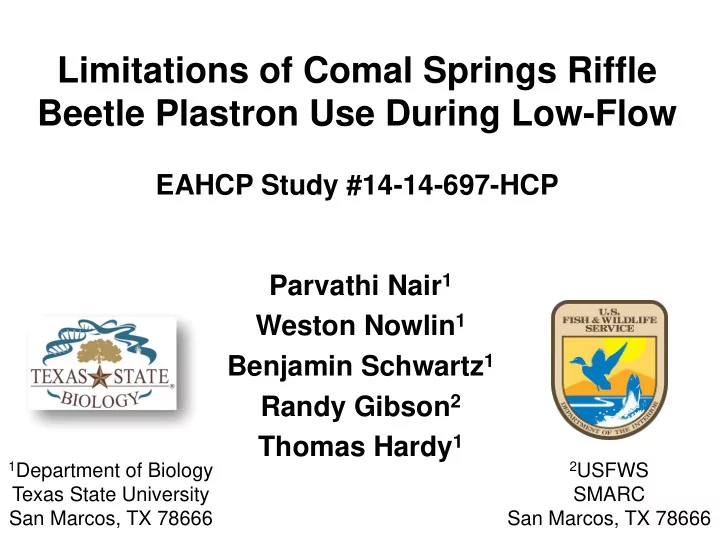

Limitations of Comal Springs Riffle Beetle Plastron Use During Low-Flow EAHCP Study #14-14-697-HCP Parvathi Nair 1 Weston Nowlin 1 Benjamin Schwartz 1 Randy Gibson 2 Thomas Hardy 1 1 Department of Biology 2 USFWS Texas State University SMARC San Marcos, TX 78666 San Marcos, TX 78666
Comal Springs Riffle Beetle and Spring Flows
Comal Springs Riffle Beetle Plastron
Comal Springs Riffle Beetle and Spring Flows O 2
Comal Springs Riffle Beetle and Spring Flows Temperature
Comal Springs Riffle Beetle and Spring Flows Temperature O 2 demand
Comal Springs Riffle Beetle and Spring Flows Temperature
Comal Springs Riffle Beetle and Spring Flows Temperature O 2
Comal Springs Riffle Beetle and Spring Flows Temperature O 2 for O 2 plastron function
Study Objectives • Examine effect of increasing temperature and decreasing DO on performance of H. comalensis – Separate effects of each factor – Not direct assessment of plastron function • Explore use of non-listed surrogate species • Compare temperature and DO responses among surrogate species and H. comalensis
Hypotheses • All species will exhibit threshold temperatures and DO concentrations, beyond which beetles will exhibit a reduction in performance • Spring-ass0ciated species ( H. comalensis and H. glabra ) will exhibit smaller ranges in temperature and DO than the surface associated species ( H. vulnerata).
Elmid Species Examined H.vulnerata H.glabra H.comalensis
Critical Limit Methodology
Beetle Collection Finnegan Springs Comal Springs (Devils River) (SMARC)
Beetle Housing • SMARC and FAB • Ambient temperatures (22- 23 o C), DO >4 mg/L • Plastic flow-through chambers • Issues with H. vulnerata – Die off over a 2-week period in August, re-collected in September – Seasonality?
Experimental System
Experimental Design • Examined responses to short-term and long-term changes in DO and temperature – Short term = minutes to hours – Long-term = Days • Short term experiments – Responses to rapid environmental changes, no time for acclimation – Thresholds not indicative of responses over longer time periods • Long term experiments – Limits of acclimation – Allows for longer term deleterious effects to manifest
Short Term Experiments • Short Term DO – Start at 4 mg/L, decreased 1mg/L every few minutes – 3 min observation period – Temperature maintained at 23 o C • Short Term Temperature – Start at 23 o C, increase temperature by 1 o C every few minutes – Maintained DO >4 mg/L – 3 minute observation period • n = 16 H. glabra , n = 12 H. comalensis • Examined for Loss Of Response (LOR) – Other consistent behaviors noted • At LOR, individuals moved to recovery chambers
Recovery Chambers
Long Term Experiments • Only H. glabra – Flows at Comal Springs, mortality issues – Funding and time • Long Term DO – Start at 4 mg/L, decreased 1mg/L over 24-h period – Observed every 2-3 hours over day – Temperature at 23 o C • Long Term Temperature – Start at 23 o C, increase 1 o C every 24 hours – Maintained DO >4 mg/L – Observed every 2-3 hours • n = 16 and 12
Data analysis • Critical temperature and DO thresholds determined as mean of observed LOR (or other recognizable behavioral responses) • Differences among species for short term experiments assessed with one-way ANOVA • Long term thresholds for H.glabra compared to data in literature for other elmids and dryopids
Short term DO Results • H. glabra – No LOR even at 0 mg/l DO for 3 minutes • H. comalensis – No LOR even at 0 mg/l DO for 3 minutes • Recovery chamber – Observed for 1-h – No lasting exposure effects
Short term Temperature Results Rapid movement F 1, 26 = 9.92 p = 0.004 31.6 45.17 28.8
Short term Temperature Results Uncoordinated movement F 1, 21 = 3.99 40.2 p = 0.059 37.3 45.17
Short term Temperature Results LOR 49.9 45.2 F 1,26 = 23.08 p < 0.001
Short term Temperature Recovery • H.comalensis – All individuals recovered within one hour. • H. glabra – All individuals recovered within an hour except one
Long term DO Results • H. glabra only – LOR at mean DO concentration 0.48 mg/L (0 – 1 mg/L) – LOR after an average of 10.2-h at <1 mg/L – All beetles recovered within 3-h
Long term Temperature Results • H. glabra only – Rapid agitated movements at around 34.7 0 C – LOR at 36.3 0 C – On an average 177.6 -h spent at temperatures above 30 0 C before LOR • Recovery chamber – Only 3/12 individuals recovered after 4-h
Implications of Low DO • Not sensitive to rapid changes in DO • Findings consistent with other studies on elmids - Stenelmis quadrimaculata exhibited LOR after an average of 60-h at 0 mg/L (Harpster 1944)
Implications of high temperature • Short term experiments – Rapid movement onset at 28 – 32 o C – Threshold temperature for both species high – H. comalensis had significantly lower than H. glabra • Long term experiment with H. glabra – Stress at 30-34 0 C • Findings consistent with other studies on elmids – Stenelmis quadrimaculata exhibited LOR at 30-33 0 C (Harpster,1944)
Potential use of surrogate • H. vulnerata – Utility as surrogate unknown • H. glabra – Promising in terms of DO responses – Limited utility as threshold temperature 5 0 C greater
Future studies • Long term threshold study for H. comalensis. • Future studies to clearly identify long term thresholds for DO and temperature by holding beetles for weeks-months • Surrogate studies in Habitat Connectivity Study (later today)
Dewatering Issues • Decline in mean daily discharge since 2010 • Marked decline in beetle habitat • Movement of beetle into hyporheos?
Acknowledgements • Funding- EAHCP • Help-Michael Markowski, Dan Huston, McLean Worsham, Amelia Everett, and Duane Friedman
Recommend
More recommend